中考英语语法复习——主谓一致
图片预览

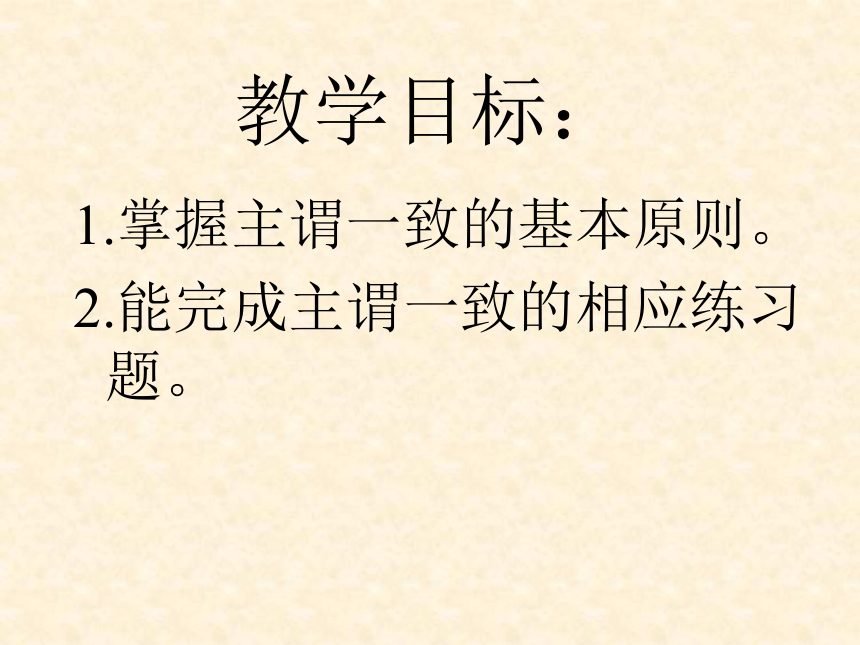
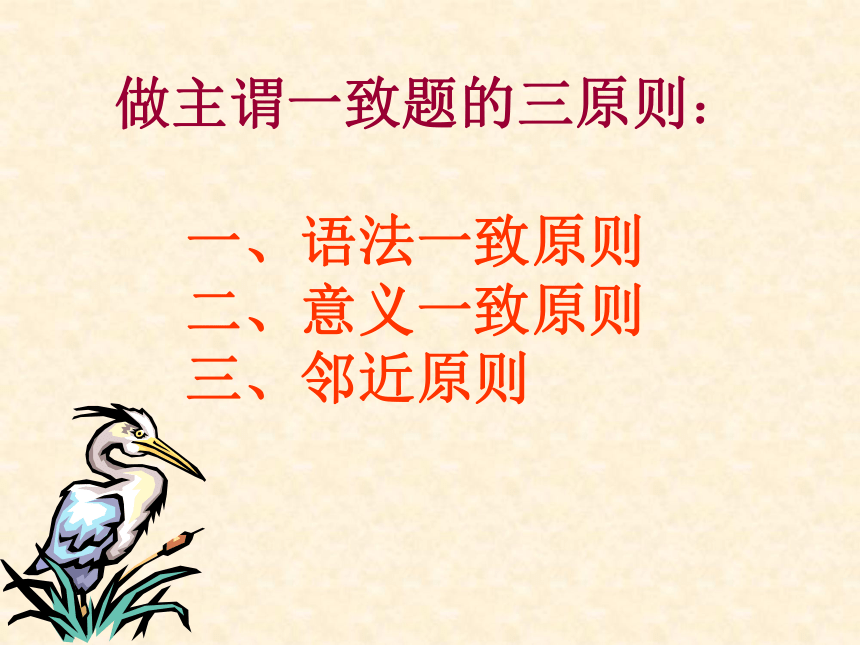
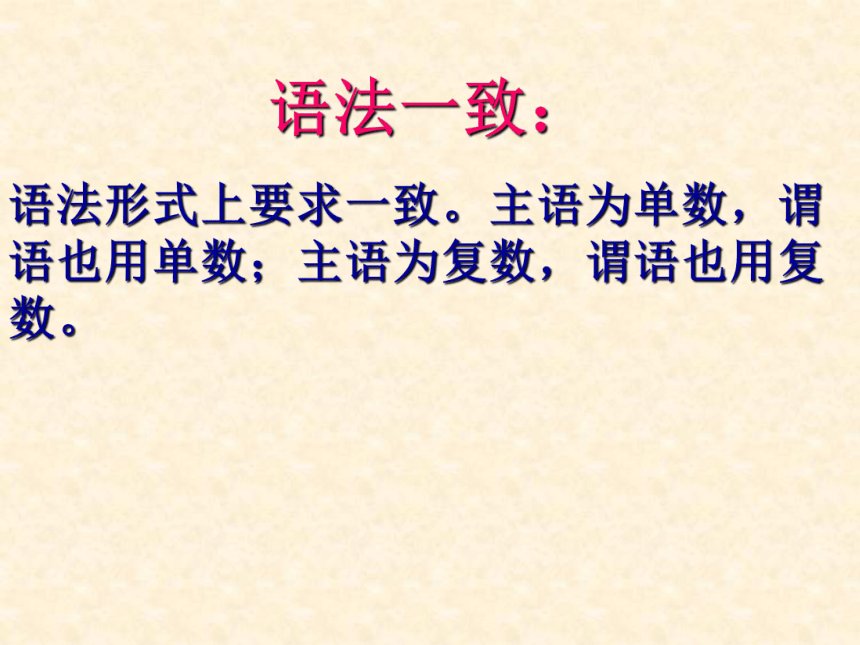
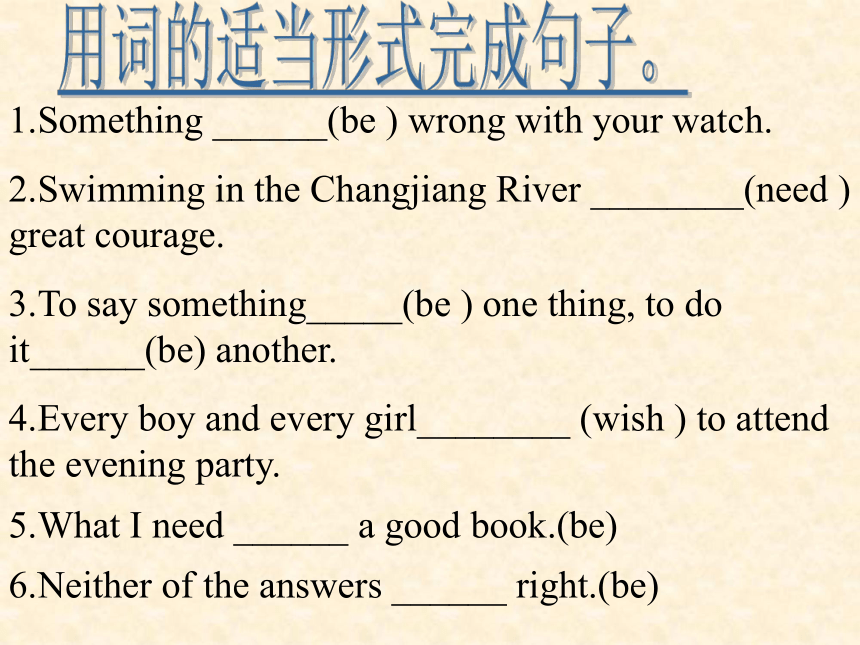
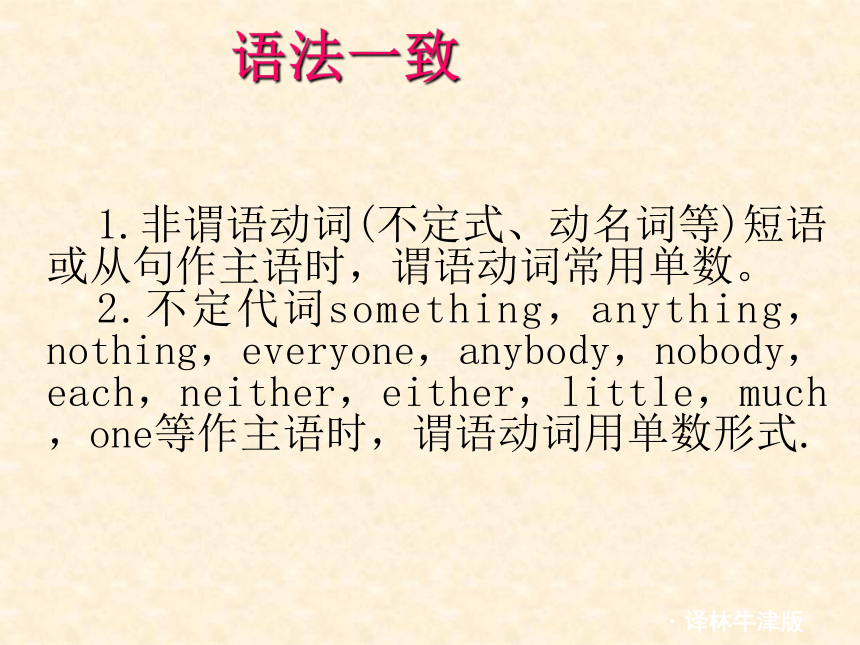
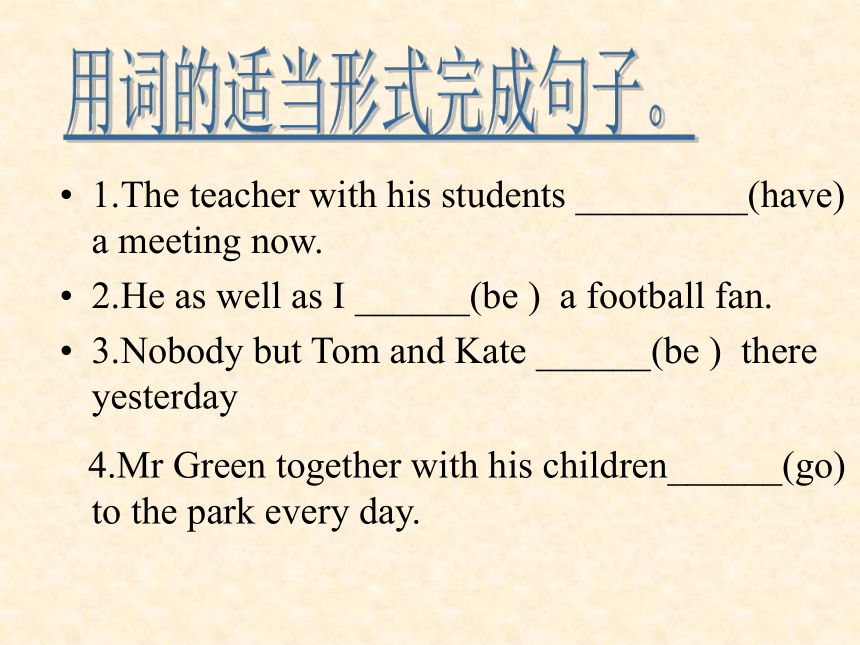
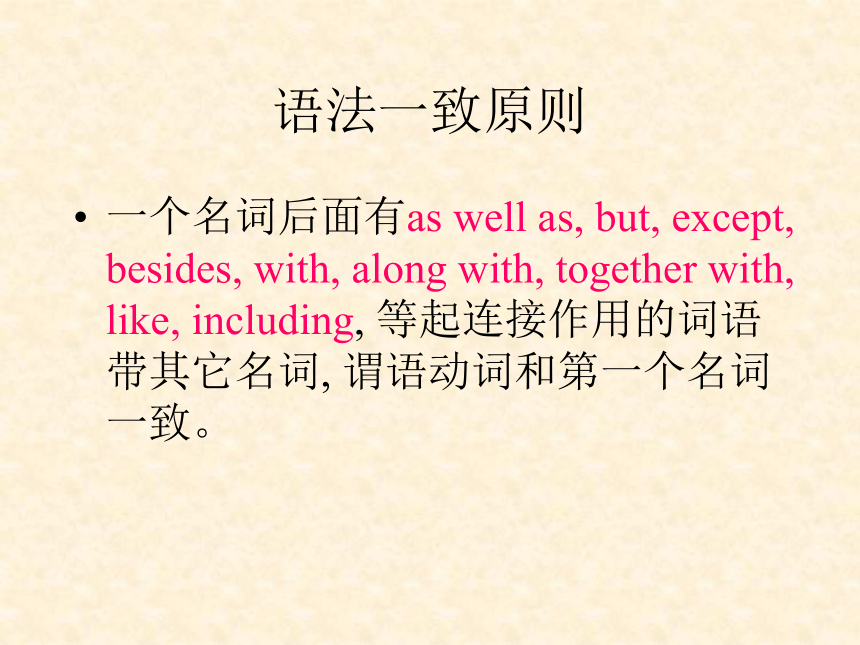
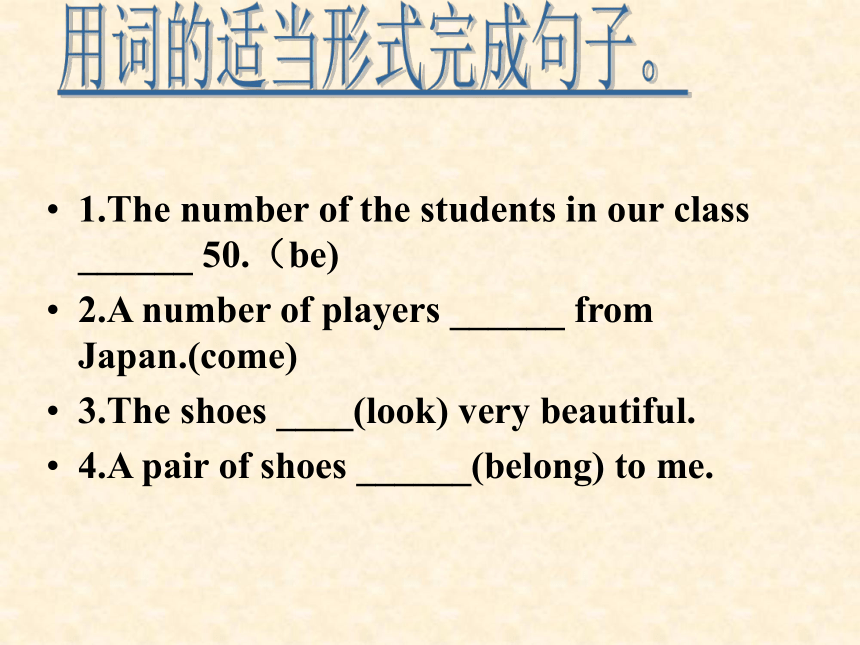
文档简介
(共26张PPT)
教学目标:
1.掌握主谓一致的基本原则。
2.能完成主谓一致的相应练习题。
做主谓一致题的三原则:
一、语法一致原则
二、意义一致原则
三、邻近原则
语法一致:
语法形式上要求一致。主语为单数,谓 语也用单数;主语为复数,谓语也用复数。
1.Something ______(be ) wrong with your watch.
2.Swimming in the Changjiang River ________(need ) great courage.
3.To say something_____(be ) one thing, to do it______(be) another.
4.Every boy and every girl________ (wish ) to attend the evening party.
5.What I need ______ a good book.(be)
6.Neither of the answers ______ right.(be)
·译林牛津版
1.非谓语动词(不定式、动名词等)短语或从句作主语时,谓语动词常用单数。
2.不定代词something,anything,nothing,everyone,anybody,nobody,each,neither,either,little,much,one等作主语时,谓语动词用单数形式.
语法一致
1.The teacher with his students _________(have) a meeting now.
2.He as well as I ______(be ) a football fan.
3.Nobody but Tom and Kate ______(be ) there yesterday
4.Mr Green together with his children______(go) to the park every day.
语法一致原则
一个名词后面有as well as, but, except, besides, with, along with, together with, like, including, 等起连接作用的词语带其它名词, 谓语动词和第一个名词一致。
1.The number of the students in our class ______ 50.(be)
2.A number of players ______ from Japan.(come)
3.The shoes ____(look) very beautiful.
4.A pair of shoes ______(belong) to me.
语法一致原则
1.“a number of …”作主语时,谓语动词用复数; “the number of…”作主语时,谓语动词用单数。
2.名词shoes,classes,clothes,trousers等作主语时,谓语动词必须用复数。但是,如果这些名词被a pair of 修饰时,谓语动词需用单数。
意义一致:
从意义的角度来处理主谓一致的关系。
主语形式虽为单数,但意义为复数,谓语动词用复数;
反之,主语形式上为复数,但意义为单数,谓语动词用
单数。
1.His family ______(be) not large. 2.The class ___________(have) a
meeting now. 3.The police __________(look) for a thief.
4.The rich _______(have) much money.
5.The poor _____(live) a hard life.
·译林牛津版
1.“the+形容词”表示一类人(the poor,the rich,the old,the young等)用作主语时,谓语动词用复数。如:
2. family,class,team,group等集体名词作主语,若指一个整体,谓语动词用单数;若指具体成员,谓语动词用复数。如:
意义一致:
1.Three fourths of the earth __________ (cover) with water.
2.Not all work difficult, not all the students
here. (be)
3.Most of the water ____(be) from Qingdao.
4.Half of the work _____(finish) already.
5.The rest of the students _____(clean) the classroom every day.
意义一致原则
all,some,none,most,any,the rest,half,分数或百分数等代词作主语时,若指复数概念,谓语动词用复数;若指单数概念,则谓语动词用单数。如:
7.The writer and the teacher (be)coming.
8.His parents young, but mine old.(be)
9.Neither of us a boy (be).
10.Not all work difficult, not all the students
here. (be)
11.What ____the population of your town (be)
are
are
are
are
is
is
is
Twenty years __________ since he left his hometown.(pass)
Ten dollars ______ enough. (be)
Maths ______ very hard.(be)
·译林牛津版
意义一致原则(即主、谓语在意义上保持一致关系。)
1.表示时间、金钱、距离、重量、长度等的复数名词作主语时,通常被看作一个整体,谓语动词用单数。
2.以s结尾的名词(news,maths,physics)本身不表示复数意义时,谓语动词通常用单数形式。
就近原则:当主语被某些关联短语连接时,谓语动词的单复数与离它最近的主语保持一致。
给句子填上is/am/are
1.There _____some milk and some bottles on the table.
2.Neither Jim nor Mary ______ right.
3.Either you or I_______going to work there.
4.Not only the students but also their teacher ____happy.
5.There ______some sheep and a child over there.
is
is
am
is
are
·译林牛津版
就近一致原则(即谓语的单、复数取决于离谓语最近的主语的单、复数形式。)
1.there be句型(当主语是系列事物时,谓语与邻近的主语保持一致。)
2.由either…or…,neither…nor…,not only…but also…等词连接并列主语时,谓语动词跟邻近的主语保持一致。如:
1.句子倒装看其 ,主语后的介词 。
2.单数名词作主语,谓语用 数,主语为复数名词,谓语动词用 数。
3..动词不定式,动名词,从句作主语用 数,定语从句的谓语动词取决于 。
4. 主语为“the number of +复数名词”时,谓语用 数,主语为“a number of +复数名词”时,谓语用 数.
5.each(each…and each…,),every(every…and every…或 some-,any-,every-,no构成的复合不定代词作主语,谓语用 数。
6.either,neither作主语,谓语动词常用 数。
复
后
语法一致
先行词
复
单
单
单
单
单
丢一边
1.由and连接两个成分,若是指同一概念,谓语用 数.
2.名词性物主代词作主语,谓语取决于该 所表示的意义。
3.时间、距离、金钱再多也是 数。
4.None of +复数名词作主语,谓语 。
5. all, some, most, any, the rest, 分数或百分数等作主语时,谓语依照后面 而确定。
6.Population作主语,谓语用 数。
单
名词
可单可复
名词的数
单
单
意义一致
Practice makes perfect
1
2
主谓一致
意义一致
就近原则
语法一致
教学目标:
1.掌握主谓一致的基本原则。
2.能完成主谓一致的相应练习题。
做主谓一致题的三原则:
一、语法一致原则
二、意义一致原则
三、邻近原则
语法一致:
语法形式上要求一致。主语为单数,谓 语也用单数;主语为复数,谓语也用复数。
1.Something ______(be ) wrong with your watch.
2.Swimming in the Changjiang River ________(need ) great courage.
3.To say something_____(be ) one thing, to do it______(be) another.
4.Every boy and every girl________ (wish ) to attend the evening party.
5.What I need ______ a good book.(be)
6.Neither of the answers ______ right.(be)
·译林牛津版
1.非谓语动词(不定式、动名词等)短语或从句作主语时,谓语动词常用单数。
2.不定代词something,anything,nothing,everyone,anybody,nobody,each,neither,either,little,much,one等作主语时,谓语动词用单数形式.
语法一致
1.The teacher with his students _________(have) a meeting now.
2.He as well as I ______(be ) a football fan.
3.Nobody but Tom and Kate ______(be ) there yesterday
4.Mr Green together with his children______(go) to the park every day.
语法一致原则
一个名词后面有as well as, but, except, besides, with, along with, together with, like, including, 等起连接作用的词语带其它名词, 谓语动词和第一个名词一致。
1.The number of the students in our class ______ 50.(be)
2.A number of players ______ from Japan.(come)
3.The shoes ____(look) very beautiful.
4.A pair of shoes ______(belong) to me.
语法一致原则
1.“a number of …”作主语时,谓语动词用复数; “the number of…”作主语时,谓语动词用单数。
2.名词shoes,classes,clothes,trousers等作主语时,谓语动词必须用复数。但是,如果这些名词被a pair of 修饰时,谓语动词需用单数。
意义一致:
从意义的角度来处理主谓一致的关系。
主语形式虽为单数,但意义为复数,谓语动词用复数;
反之,主语形式上为复数,但意义为单数,谓语动词用
单数。
1.His family ______(be) not large. 2.The class ___________(have) a
meeting now. 3.The police __________(look) for a thief.
4.The rich _______(have) much money.
5.The poor _____(live) a hard life.
·译林牛津版
1.“the+形容词”表示一类人(the poor,the rich,the old,the young等)用作主语时,谓语动词用复数。如:
2. family,class,team,group等集体名词作主语,若指一个整体,谓语动词用单数;若指具体成员,谓语动词用复数。如:
意义一致:
1.Three fourths of the earth __________ (cover) with water.
2.Not all work difficult, not all the students
here. (be)
3.Most of the water ____(be) from Qingdao.
4.Half of the work _____(finish) already.
5.The rest of the students _____(clean) the classroom every day.
意义一致原则
all,some,none,most,any,the rest,half,分数或百分数等代词作主语时,若指复数概念,谓语动词用复数;若指单数概念,则谓语动词用单数。如:
7.The writer and the teacher (be)coming.
8.His parents young, but mine old.(be)
9.Neither of us a boy (be).
10.Not all work difficult, not all the students
here. (be)
11.What ____the population of your town (be)
are
are
are
are
is
is
is
Twenty years __________ since he left his hometown.(pass)
Ten dollars ______ enough. (be)
Maths ______ very hard.(be)
·译林牛津版
意义一致原则(即主、谓语在意义上保持一致关系。)
1.表示时间、金钱、距离、重量、长度等的复数名词作主语时,通常被看作一个整体,谓语动词用单数。
2.以s结尾的名词(news,maths,physics)本身不表示复数意义时,谓语动词通常用单数形式。
就近原则:当主语被某些关联短语连接时,谓语动词的单复数与离它最近的主语保持一致。
给句子填上is/am/are
1.There _____some milk and some bottles on the table.
2.Neither Jim nor Mary ______ right.
3.Either you or I_______going to work there.
4.Not only the students but also their teacher ____happy.
5.There ______some sheep and a child over there.
is
is
am
is
are
·译林牛津版
就近一致原则(即谓语的单、复数取决于离谓语最近的主语的单、复数形式。)
1.there be句型(当主语是系列事物时,谓语与邻近的主语保持一致。)
2.由either…or…,neither…nor…,not only…but also…等词连接并列主语时,谓语动词跟邻近的主语保持一致。如:
1.句子倒装看其 ,主语后的介词 。
2.单数名词作主语,谓语用 数,主语为复数名词,谓语动词用 数。
3..动词不定式,动名词,从句作主语用 数,定语从句的谓语动词取决于 。
4. 主语为“the number of +复数名词”时,谓语用 数,主语为“a number of +复数名词”时,谓语用 数.
5.each(each…and each…,),every(every…and every…或 some-,any-,every-,no构成的复合不定代词作主语,谓语用 数。
6.either,neither作主语,谓语动词常用 数。
复
后
语法一致
先行词
复
单
单
单
单
单
丢一边
1.由and连接两个成分,若是指同一概念,谓语用 数.
2.名词性物主代词作主语,谓语取决于该 所表示的意义。
3.时间、距离、金钱再多也是 数。
4.None of +复数名词作主语,谓语 。
5. all, some, most, any, the rest, 分数或百分数等作主语时,谓语依照后面 而确定。
6.Population作主语,谓语用 数。
单
名词
可单可复
名词的数
单
单
意义一致
Practice makes perfect
1
2
主谓一致
意义一致
就近原则
语法一致
同课章节目录
- 词法
- 名词
- 动词和动词短语
- 动词语态
- 动词时态
- 助动词和情态动词
- 非谓语动词
- 冠词
- 代词
- 数词和量词
- 形容词副词及其比较等级
- 介词和介词短语
- 连词和感叹词
- 构词法
- 相似、相近词比较
- 句法
- 陈述句
- 一般疑问句和否定疑问句
- 特殊疑问句及选择疑问句
- 反意疑问句
- 存在句(There be句型)
- 宾语从句
- 定语从句
- 状语从句
- 主谓一致问题
- 简单句
- 并列句
- 复合句
- 主谓一致
- 主、表语从句
- 名词性从句
- 直接引语和间接引语
- 虚拟语气
- 感叹句
- 强调句
- 倒装句
- 祈使句
- 句子的成分
- 句子的分类
- 题型专区
- 单项选择部分
- 易错题
- 完形填空
- 阅读理解
- 词汇练习
- 听说训练
- 句型转换
- 补全对话
- 短文改错
- 翻译
- 书面表达
- 任务型阅读
- 语法填空
- 其他资料
